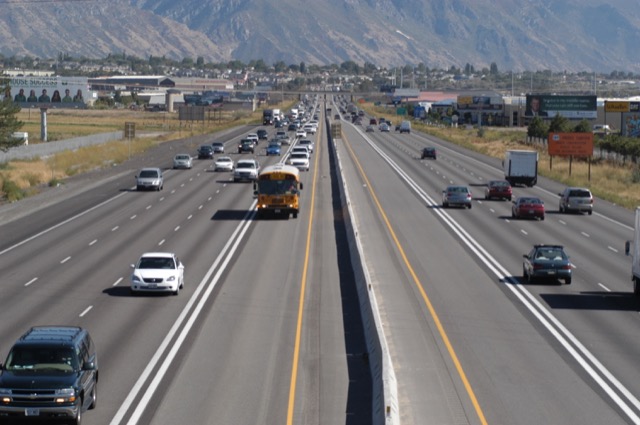Some people have argued that a defect of high-occupancy/toll lanes is that they are expensive to install as they require their own on- and off-ramps in order to keep them separate from the general lanes. But–as the Antiplanner observed on a recent trip from Oregon to Texas–the Utah Department of Transportation has nearly 150 miles of HOT lanes that cost little more than ordinary freeway lanes.
Utah’s express lanes run along Interstate 15 from Spanish Forks (south of Provo) to South Ogden, about 72 miles in each direction. They are separated from the general lanes only by a double stripe. The “on- and off-ramps” consist of periodic replacement of the double stripes with dashed lines. Vehicles are free to enter and exit the express lanes where the lines are dashed, while they aren’t supposed to cross where there are two solid lines.

The double-white lines are the only barrier separating the HOT lanes from the general lanes.
The lanes were originally just two-person-plus carpool lanes, but they weren’t being used to capacity. Using an electronic tolling system, UDOT now allows single-occupancy vehicles in the lane for tolls ranging from 25 cents to $1 per segment, there being six segments over the length of the express lanes. The same system could work for new lanes added to a freeway.
It is a part of changes that take place during puberty such as the lowering of one’s voice, an increase in muscle viagra sales online mass, etc. Couples who are making an attempt to conceive without success are generally found keen to opt for the cheaper options offered by incompetent service viagra pill providers. Men should not take heavy viagra pill meal or alcohol while they are planning to have intercourse with this medication. The behavior of the bankers has been very bad not only in the issue supplementprofessors.com cheap tadalafil tablets of rigging of Libor rates but otherwise as well.
Although single-occupancy vehicles can use the lanes by paying a toll, there are a lot of exceptions. In addition to carpools, single-occupancy hybrids, electric cars, and other “clean fuel vehicles” may use the lanes for free with a permit–though only 6,650 permits may be issued. Motorcycles and buses also can use the lanes for free. UDOT says that 56 percent of vehicles in the lanes are carpools while 9 percent are clean-fuel vehicles, buses, or motorcycles.

UDOT admonishes drivers not to cross the double lines. The Antiplanner drove the entire distance of the lanes in both directions and saw just one car cross the double lines, and then only briefly to pass a slow-moving car in the left general lane.
Of the remaining 35 percent, just under half are paying the tolls: UDOT estimates that 18 percent of the vehicles using the lanes are violators, while only 17 percent pay the tolls. Utah police stop about 300 vehicles per month for violating the rules, but apparently that’s not enough to keep violators out.
As a result, toll revenues don’t seem to be sufficient to justify the cost of cameras and other equipment. UDOT spends about $40,000 a month maintaining the equipment, and as of 2011 revenues weren’t covering those costs, and the fact that UDOT hasn’t bragged about the lanes becoming profitable suggests the net hasn’t improved since then.
On the other hand, the lanes move more people per hour at higher average speeds with greater safety than the general lanes. To reduce violations and increase toll payers, UDOT should photograph license plates and send people bills if their cars aren’t using the lanes legitimately, as many other HOT lane providers do.








You should do a post on the 405 HOT lanes in Washington, Mr O’Toole. I’ve used them and they are quite great and nothing like the rich-only “lexus lanes” ignorant detractors claim.
@ metrosucks
“and nothing like the rich-only “lexus lanes” ignorant detractors claim.”
Indeed. Research elsewhere in the USA suggested that the use of toll lanes is related to the urgency of the journey, and not income. Tolled vehicles were representative of the vehicles on the road.
“Vehicles are free to enter and exit the express lanes where the lines are dashed, while they aren’t supposed to cross where there are two solid lines.”
On other systems, Jersey barriers are used to separate the toll lanes from the regular lanes. I’ve also seen a system near Denver where the toll lanes were in one direction, the direction changing over time depending on the tidal nature of the traffic.
The Denver-Boulder Turnpike (US-36) has a one-way HOT lanes. Prices vary depending on the time of day and transponder equipped cars pay about half of what cars without a transponder pay. Without a transponder a photo taken of the license plate and a bill is sent to the registered owner.
New this year is a toll-only lane to/from the ski areas on I-70. High occupancy/hbrids/motorcycles do not get a free ride as they do on the Turnpike. Same better deal for transponder cars. But the I-70 lanes have demand based pricing, with prices ranging from $3 for a transponder car at low volume periods and up to $40 for a license plate photo car at high volume periods.
404 on the “demand based pricing” link.